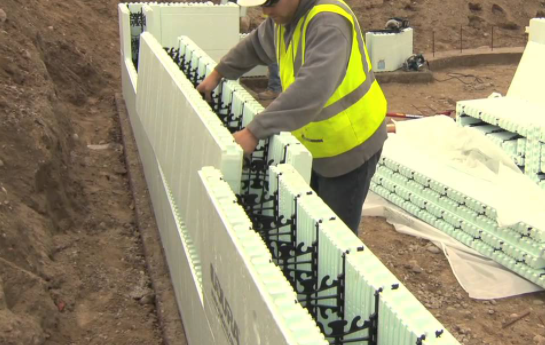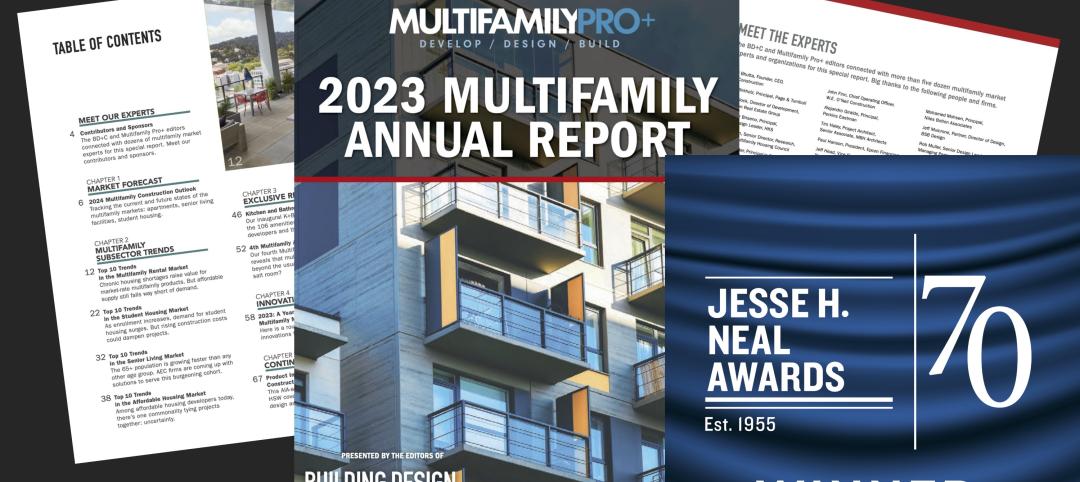Insulating concrete forms have a long history of success in low-rise buildings, but now Building Teams are specifying ICFs for mid- and high-rise structures—more than 100 feet. ICF walls can be used for tall unsupported walls (for, say, movie theaters and big-box stores) and for multistory, load-bearing walls (for hotels, multifamily residential buildings, and student residence halls).
Our trusted ICF experts offer the following tips for designing and constructing tall ICF walls:
1. Pre-plan your job by drawing a simple cross section with the ICF you are using.
The cross section will show you how openings line up with the coursing of the ICF joints and where embeds will be placed, says Glen Klassen, regional manager with ICF manufacturer Arxx, Cobourg, Ont. "During the build process, your crew can follow this cross section to know when to stop placing forms and start placing embeds."
2. Account for the ICF formwork course height.
Designers can greatly reduce the amount of formwork cuts the contractor will be required to make by considering the course height of the ICF product when designing the walls, says Kelvin Doerr, VP of engineering and technical services for Reward Wall Systems, Omaha, Neb. Doerr says architects should factor in wall heights, window heights, and floor elevations when possible.
3. Base concrete slump and aggregate size on ICF manufacturer recommendations.
Both concrete slump and aggregate size are impacted by the formwork tie configuration within the formwork cavity, as well as by the amount of open space available around the ties to allow concrete to effectively flow within the forms, says Donn C. Thompson, AIA, LEED AP, CGP, director of Low Rise Buildings with the Portland Cement Association, Skokie, Ill. "Ties with smaller openings will require smaller aggregate to insure the concrete flows effectively through the forms," he says.
Arxx's Klassen offers this rule of thumb: If the concrete is restricted slightly at the top form around the rebar before flowing into the wall, it's just right. If the concrete gets restricted to the point of not flowing down into the wall, it's too low of a slump. If the concrete flows freely into the wall with no restriction, it is likely too high a slump.
4. Consider the STC rating needed for the job.
Once you know the sound transmission class, consider what needs to be added to the ICF wall if an STC rating of 50 or higher is required, says John Krzic, accounts manager with Amvic Building System, Toronto. "For example, by adding a resilient channel to the ICF wall and then installing the drywall, it will increase the STC rating of the wall assembly," says Krzic.
5. Take steps to ensure the concrete completely fills the form.
"One concern with tall ICF walls is that concrete may not fill all parts of the form since the walls are generally thin," says Lionel Lemay, PE, SE, LEED AP, CAE, senior VP of sustainable development, National Ready Mixed Concrete Association, Silver Spring, Md. To help avoid holes and gaps in the concrete pour, Lemay advises the following:
-
Place a single layer of reinforcement in the center of the wall to allow for more space on either side of the reinforcement.
-
Allocate greater spacing of reinforcement than is required in ACI 318 14.5, which requires a maximum spacing of three times the wall thickness or 18 inches, whichever is smaller.
Consider using self-consolidating concrete. "Keep in mind that self-consolidating concrete exerts greater pressure on forms, so additional bracing will be required for most ICF systems," says Lemay.
6. Specify an ICF that is fully reversible.
"These forms have no top, bottom, left, or right side, and, therefore, are more efficiently stacked, reducing construction costs," says Reward's Doerr.
7. Repeat window patterns when possible.
In multistory load-bearing applications such as multifamily, senior living, and hotel projects, try to repeat window patterns from floor to floor so that the openings remain stacked for the full height of the wall assembly, says PCA's Thompson. This maximizes efficiency in design and construction.
8. Make sure, in noncombustible Type I, II, III, and IV multistory building projects, that the noncombustible floor system intersects the foam plastic on the interior of the building.
"The foam plastic must not be continuous from floor to floor, and special detailing is necessary to meet these requirements," says Doerr. In addition, IBC states that interior walls must be covered with a 15-minute thermal barrier. Doerr says half-inch gypsum board will do the trick.
9. Brace from the inside.
The higher the wall, the more difficult and costly it is to reach the exterior of the wall with bracing, says Amvic's Krzic. "Proper bracing will help to ensure that walls will be straight and level," he says. "This is important as it can affect other sub trades, wall finishes, and structural integrity of the building."
More on insulating concrete forms at:
13 tips on working with insulating concrete forms
How Insulated Concrete Forms Help Reduce Energy Consumption
English inspired church built with insulated concrete forms
Related Stories
Resiliency | Sep 3, 2024
Phius introduces retrofit standard for more resilient buildings
Phius recently released, REVIVE 2024, a retrofit standard for more resilient buildings. The standard focuses on resilience against grid outages by ensuring structures remain habitable for at least a week during extreme weather events.
Contractors | Aug 21, 2024
The average U.S. contractor has 8.4 months worth of construction work in the pipeline, as of July 2024
Associated Builders and Contractors reported today that its Construction Backlog Indicator held steady at 8.4 months in July, according to an ABC member survey conducted July 22 to Aug. 6. The reading is down 0.9 months from July 2023.
Building Team | Aug 13, 2024
Don't miss out! 2024 Women in Residential+Commercial Construction Conference, September 18-20, Phoenix
This annual conference gathers 300+ women in construction for three transformative and education-rich days packed with industry speakers, AIA-accredited sessions, breakout education tracks, roundtable discussions, panels, and networking events.
Building Team | Jul 3, 2024
So you want to get published: What’s next?
In the AEC industry, securing media attention is no longer a niche endeavor but an essential component of a holistic marketing strategy.
Building Team | Apr 30, 2024
Building Design+Construction wins a 2024 Jesse H. Neal Award for editorial excellence
The editors of Building Design+Construction and Multifamily Pro+ were honored last week with a 2024 Jesse H. Neal Award for editorial excellence for their work on the “2023 Multifamily Annual Report.” The 76-page special report, published last October, won the Neal Award for Best Subject-Related Package.
Engineers | Sep 8, 2023
Secrets of a structural engineer
Walter P Moore's Scott Martin, PE, LEED AP, DBIA, offers tips and takeaways for young—and veteran—structural engineers in the AEC industry.
Giants 400 | Aug 30, 2023
Top 75 Engineering Firms for 2023
Kimley-Horn, WSP, Tetra Tech, Langan, and IMEG head the rankings of the nation's largest engineering firms for nonresidential buildings and multifamily buildings work, as reported in Building Design+Construction's 2023 Giants 400 Report.
Building Team | Aug 28, 2023
Navigating challenges in construction administration
Vessel Architecture's Rebekah Schranck, AIA, shares how the demanding task of construction administration can be challenging, but crucial.
Giants 400 | Aug 22, 2023
2023 Giants 400 Report: Ranking the nation's largest architecture, engineering, and construction firms
A record 552 AEC firms submitted data for BD+C's 2023 Giants 400 Report. The final report includes 137 rankings across 25 building sectors and specialty categories.
Senior Living Design | Aug 7, 2023
Putting 9 senior living market trends into perspective
Brad Perkins, FAIA, a veteran of more than four decades in the planning and design of senior living communities, looks at where the market is heading in the immediate future.

















